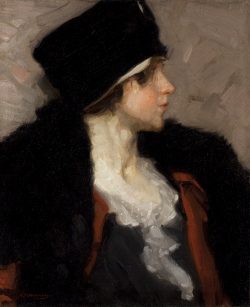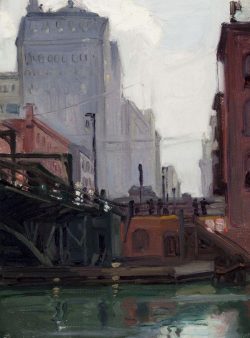E. Martin Hennings in Munich, from a photograph circa 1914, collection of Robert R. White, Albuquerque, New Mexico, reproduced in Stark Museum of Art, Color, Pattern & Plane: E. Martin Hennings in Taos (Orange, TX: Nelda C. and H.J. Lutcher Stark Foundation, 1986).

E. Martin Hennings 1886–1956
Best known for paintings of American Indians in the Southwest, Ernest Martin Hennings was born in Pennsgrove, New Jersey, but grew up in Chicago. In 1904 he graduated with honors from the Art Institute of Chicago’s school and over the next eight years he returned there sporadically for further study. Early in his career, Hennings worked mostly as an illustrator and mural painter. In 1912, after winning second place in the prestigious Prix de Rome competition of the École des Beaux-Arts in Paris, he went to Munich for two years of study at the Royal Academy; there he adopted the school’s trademark fluid brushwork and restrained color, demonstrated in his early painting Black Furs. After traveling in Europe, Hennings returned to Chicago in 1915. The following year, he won both the Englewood Woman’s Club Prize, for a group of paintings exhibited in the Art Institute’s annual “Chicago and Vicinity” show, and the Ullrich Gold Medal from the Palette and Chisel Club.
In 1917, industrialist and art patron Oscar Mayer and former Chicago mayor Carter H. Harrison encouraged Hennings to visit Taos, New Mexico, a vital artists’ colony. Like his friends Walter Ufer and Victor Higgins, fellow Chicago painters who preceded him to Taos, Hennings was inspired to change his style radically under the influence of the region’s strong color and light. He produced numerous images of American Indians and other local types in the dramatic landscape of New Mexico. Hennings exhibited widely between the late 1910s and the early 1930s at such important venues as the Pennsylvania Academy of the Fine Arts in Philadelphia, the National Academy of Design in New York, and the Corcoran Gallery of Art in Washington, D.C., as well as the Art Institute. He won numerous prizes, notably the Art Institute’s Clyde M. Carr Prize in 1922 and the Martin B. Cahn Prize the following year.
In 1924 Hennings was elected to membership in the exclusive Taos Society of Artists. Sources often note that he became a permanent resident of Taos in 1921, yet he appears to have remained a significant figure in the Chicago art world until around 1932, the last year he was included in a “Chicago and Vicinity” annual show. He also exhibited his work at the Chicago Galleries Association, another important venue for Chicagoans in the late 1920s and 1930s. Beyond Chicago and Taos, Hennings traveled to Mexico, California, and, in 1926–1927, to southern Europe and Morocco. He is nonetheless indelibly associated with Taos and with the solidly naturalistic approach to painting practiced by its conservative artists in the interwar period.
Wendy Greenhouse, PhD

